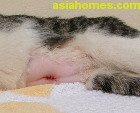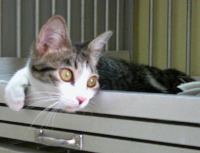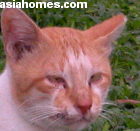|
Tips for Expats with Cats. Sponsored by Asiahomes Internet
Here are 12 TIPS for a longer life for your cats.
 1. Vaccination against cat flu, feline enteritis and feline leukaemia virus. Annual
booster vaccinations are important, particularly if the cat will
encounter many cats, e.g. at a cattery, but are forgotten by most cat owners in
Singapore. Some cat owners do not want to vaccinate against the leukaemia virus to
save costs. Cat flu is common in Singapore and cat owners
may have
seen the sneezing and runny nose of many stray cats or in their cats
after boarding at a cattery.
1. Vaccination against cat flu, feline enteritis and feline leukaemia virus. Annual
booster vaccinations are important, particularly if the cat will
encounter many cats, e.g. at a cattery, but are forgotten by most cat owners in
Singapore. Some cat owners do not want to vaccinate against the leukaemia virus to
save costs. Cat flu is common in Singapore and cat owners
may have
seen the sneezing and runny nose of many stray cats or in their cats
after boarding at a cattery.
However, they seldom see cats suffering from feline leukaemia. Feline Leukaemia
virus (FeLV) is contracted at a young age and there may be no signs till the cat becomes
older. The white blood cells become cancerous, multiplying in large numbers in glands like
the thymus and causing death when the cat grows up.
Feline immunodeficiency virus (FIV) and feline infectious peritonitis (FIP) are still
important virus but there are no vaccines to prevent these two diseases in
Singapore in 2003.
FIV attacks the immune system in a similar way to HIV in people. It is spread by cat bites
during fights, particularly in entire male cats. Neutering or castration of your wandering
male cat will reduce the chances of it being involved in cat fights. Of course, it
is best not to let your cat wander as many cats are killed by vehicles, especially those
young ones trying to cross the expressways.
FIP is a feline coronavirus usually causing a mild diarrhoea in cats. However, in some
cats, the virus mutates and the cat's immune system over-reacts. Excessive fluid
accumulates in the chest and/or within the abdomen. You can see the cat with a big
distended "stomach" and/or a cat with breathing difficulty. There is no
cure for this stage of the disease. This disease is common in households with many
cats living indoors and sharing litter trays. The FIP virus builds up in such and
environment and mutates to cause the FIP.
2. Neutering of male and female cats. They are likely to live longer and not stray
and get lost.
3. Feed a good quality complete diet. If your cat tends to get fat after
neutering or is the "fat cat" type, feed a diet with low calories.
4. Don't keep too many cats or use one litter tray per two cats in a multi-cat
household to prevent the building up of the FIP virus.
5. Seek prompt veterinary advice if your cat becomes soiled with substances that can
be poisonous. Some Singaporeans love to apply iodine or Chinese medical oils to cat
wounds and these may be toxic to the cats as cat livers are not so efficient at
detoxification.
6. Never give cats "human medication" or drugs that have not been
prescribed by the vet. Drugs safe for people may kill cats.
7. Cats over 8 years old will need a detailed veterinary examination. Possibly a
blood test by your vet. Usually they have bad breadth and decayed teeth and will
need dental scaling or extraction.
8. If your older cat drinks lots of water, this is not normal. Do consult your
vet early as this may be a sign of kidney disease.
9. White cats should be kept away from strong sunlight as they develop squamous cell
carcinoma on their nose and ears. You can apply sunblock but they may not like
it.
10. Stop your cat roaming out of the house or garden. This may be the best tip
for your cats to live longer lives. Vehicle accidents, viral and bacterial
infections from cat bites are common.
11. One common case is of cats falling down from high rise apartments. Many do survive as
cats seem to know how to land on their feet. They have a flexible body and joints unlike
people. However, putting up a wire mesh on windows may prevent such
problems.
12. Male cats having difficulty passing urine? Do consult your
veterinarian early as the cause may be an infection or an
obstruction of the urethra by urinary "sand" or
"stones". A special prescription diet and plenty of
drinking water may be the solution. Some cats don't drink and are
fed solely dry feed. This may predispose the cat to urinary tract
obstruction.
Educational tips for pet
lovers.
Article written in Jan 28, 2003.
The vet nearly snipped the
cat's left ear
"She looks pregnant,"
Mrs Forster said as her Queen's English crackled over the mobile
phone. She was an athletic looking woman who looked as if she
would never miss a work out at the gym. Taller than the average
Singaporean Chinese girl, she was lean and her biceps muscles were
firm and strong to handle the strongest horse.
She might have played golf a lot under Singapore's unforgiving
blazing sun or just enjoyed horse riding as her light chocolate
brown tan would be the enjoy of most fair Caucasians in Europe and
many in Singapore.
"Is it too late to spay her?" Mrs Forster enquired. Pregnancy in a stray cat
was not a joyous occasion to celebrate for cat caring persons. Most
Singaporeans at the riding club feed the stray cat but seldom would
they think of spaying her.
This common looking cat belonged to nobody, but there would always be a
bowl of cat food and water for her near the chief instructor's
office. The expatriate
riding instructors, volunteers and riders would make sure that this cat
thrives and now she was going to be a mother.
.
I was at the club treating a horse with colic, a condition known as
stomach ache by some people when Mrs Forster asked me about spaying
this stray cat.
She had been trying to get me
to spay the cat and I had asked her to refer to the Club Manager who might have funds for
stray cat spay or refer the cat to a Club retained veterinarian who provided
stray cat spays.
Spaying a stray cat involves a lot of responsibilities if something goes wrong,
the whole riding club expatriates and horse lovers would know that I
was an incompetent vet.
I was
not keen to do it. Firstly, the cost must be minimal and vets who do
a large number of stray cats spay may find this feasible.
Secondly, the cat is usually taken back
immediately after surgery. Spaying is a major operation. Infection control is very difficult. She has no indoor and clean home to
go to and being left outdoors, her operation site may get infected. The cat will lick the
inflamed site and chew off the stitches as they become itchy.
The operation site would be opened and gut would spill out of
the burst open operation site. The poor cat tries to resolve the
inflamed and itchy protruding guts by licking the
guts. More guts which would become grossly contaminated by bacteria
and dirt now. It would be a very painful death and the blame would
be on the operating veterinarian.
Now, Mrs Forster phoned me with a sense of urgency to make an appointment to spay the cat
and I could not say no since she cared so much for a stray. She took a taxi to the clinic
with an expatriate friend a a little girl.
The little girl put the cat inside a blue plastic carrier which was the
smallest I had ever seen and I thought this must be a new type of
kitten carrier. It was actually for toys but the cat fitted in nicely as she was
small by European standards.
I put the cat on the examination table and felt her abdomen with my fingers for foetal
lumps which had been palpated by Mrs Forster. There
were around four small lumps in the middle area of the abdomen.
"The cat could be pregnant or those lumps could be stools." I said. The lumps
were very small, around 4 mm in diameter and they could be faecal lumps as they were
further up the dorsal abdomen.
No vets like to spay pregnant cats. A long incision over 20 cm would have to be made to
extract the golf-ball-sized or larger foetal lumps instead of a small cut for a
non-pregnant cat.
More time would be spent and the anaesthetic risk of dying would be much greater. Somehow,
it was not a good feeling to do an abortion of living creatures.
 Fortunately, the cat was not pregnant. My scalpel cut 5 cm into
the skin and fibrous line joining the left and right abdominal muscle to open up the
abdomen. Then I hooked up the ovaries and uterine horns easily. The ovaries
were enlarged and very red. Fortunately, the cat was not pregnant. My scalpel cut 5 cm into
the skin and fibrous line joining the left and right abdominal muscle to open up the
abdomen. Then I hooked up the ovaries and uterine horns easily. The ovaries
were enlarged and very red.
The uterine horns were still thin but were blood shot in
colour and filling up unlike the one you saw in the picture of a dog
being spayed.
 This
indicated that the cat was in early pregnancy or in the middle of
estrus or fertile period. The muscle and skin openings were
stitched using 2/0 catgut. A simple operation
lasting around five minutes. This
indicated that the cat was in early pregnancy or in the middle of
estrus or fertile period. The muscle and skin openings were
stitched using 2/0 catgut. A simple operation
lasting around five minutes.
However, the after care is practically non-existent in most stray cats. They get returned
to the wild.
How does one identify whether a stray cat had been neutered?
In many countries, including Singapore, the vet snips off 0.6mm from the left ear
tip. The cat looks unbalanced in its ear shape. I presumed this would be the
case. Fortunately I asked Mrs Forster about the ear tipping procedure.
 "No," she said firmly, as if I
had asked a silly question. "The cat will be inside the riding
club and no catch catcher would be around." "No," she said firmly, as if I
had asked a silly question. "The cat will be inside the riding
club and no catch catcher would be around."
Well, I the European culture being kind to animals means that cutting the
ear tip mutilates the appearance of this cat. It is cruelty no
doubt.
I boarded the cat for five days without charge as I knew it would be
unfair for Mrs Forster to pay although she would pay if asked. I
knew that this stray cat would be left in the open
area of the stables and given the freedom to roam the hills of the riding
club after spaying in most cases and I did not ask about the
post-operation care.
The hot and humid climate
of Singapore would introduce bacteria into her operation site within 2 hours, as fast as
that. She would then tear at her stitches and made a big hole in her abdomen. That meant
more expense for Mrs Forster. The cat might die from peritonitis, an infection of the
inside of the abdomen despite intensive and expected free treatment. It was treatment or
death and the veterinarian was held responsible for either outcome.
This would be too much for Mrs Forster and not good for my reputation. That is why I
usually insist on boarding for a few days after spaying a stray cat.
The kittenish-looking cat did not eat for the
first two days after surgery but cleaned up the cat feed after that. She meowed at me
whenever I saw her. She was a quiet female resting in the cage.
Her stitches would dissolve by themselves unless she removed them earlier. Another five
days would be sufficient time for the skin to heal well and for the bandage to be cut
off.
 I could see that the bandage
was not able to cover the stitch owing to the curved nature of the body. She did not
bother licking the stitch during boarding as it was not irritating to her. The operation
site was not inflamed as manifested by a reddish discoloration and
swelling and therefore she did not
bother it. I could see that the bandage
was not able to cover the stitch owing to the curved nature of the body. She did not
bother licking the stitch during boarding as it was not irritating to her. The operation
site was not inflamed as manifested by a reddish discoloration and
swelling and therefore she did not
bother it.
Mrs Forster was a kind expatriate as she used her own money and took the trouble to spay a
stray cat so as to prevent unwanted pregnancies. At the club, a Caucasian
riding instructress ensured that the cat was checked and the stitches were
taken out by the cat herself two days later.
The cat was full of good health when I saw her a few weeks later. I
met Mrs Forster waiting at the Club for somebody at noon one day and
enquired about her cat. "She scratched me," Mrs Forster
laughed. "But it was a playful scratch." Maybe this cat
had an elephant memory and was afraid that Mrs Forster would dump
her at a veterinarian.
This was one of the few fortunate stray cats to be so well cared for
by the riding people. It is extremely difficult to find homes for stray kittens and it is reported that
Singapore's cat control agency and the animal shelter culled 20,000 cats
and dogs a year. Culling
usually meant euthanasia, death by lethal injections. Some of the stray cats suffer cat
flu but this is a hazard of freedom.
 |
 |
| Looked
more like a young kitten but she could be a mother at
around six months of age. |
A stray cat
has cat flu symptoms. Unable to groom properly. |
I just hope the animal control officer will not come to the club and round up the stray
cats for euthanasia when the expatriates are not around.
STRAY CAT VOLUNTEER CARE SCHEME (Equivalent to the
Trap-Neuter-Release scheme in some areas of the U.S.A).
 Singapore
from the year 2000, has a neighbourhood cat caring scheme whereby the
government cat catchers would not impound
cats with the left ear tipped provided some kind soul would be
responsible to look after them. Singapore
from the year 2000, has a neighbourhood cat caring scheme whereby the
government cat catchers would not impound
cats with the left ear tipped provided some kind soul would be
responsible to look after them.
 It was fortunate
that I had asked Mrs
Forster about ear tipping of the stray cat of the riding club. It was fortunate
that I had asked Mrs
Forster about ear tipping of the stray cat of the riding club.
Stray dogs do not have such a scheme and it is every dog for himself
whenever the dog catchers come around.
UPDATE: Since 2003, all Singapore stray cats will be
impounded whether they have been spayed or not. Clipped-eared or
tipped eared cats are not exempted from this policy.
|
 TOA
PAYOH VETS
TOA
PAYOH VETS  TOA
PAYOH VETS
TOA
PAYOH VETS